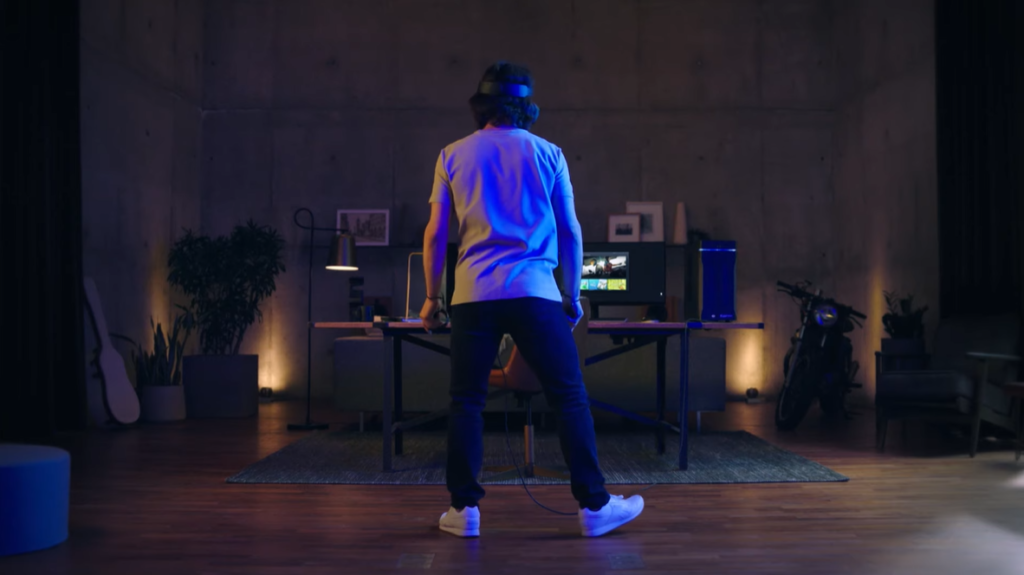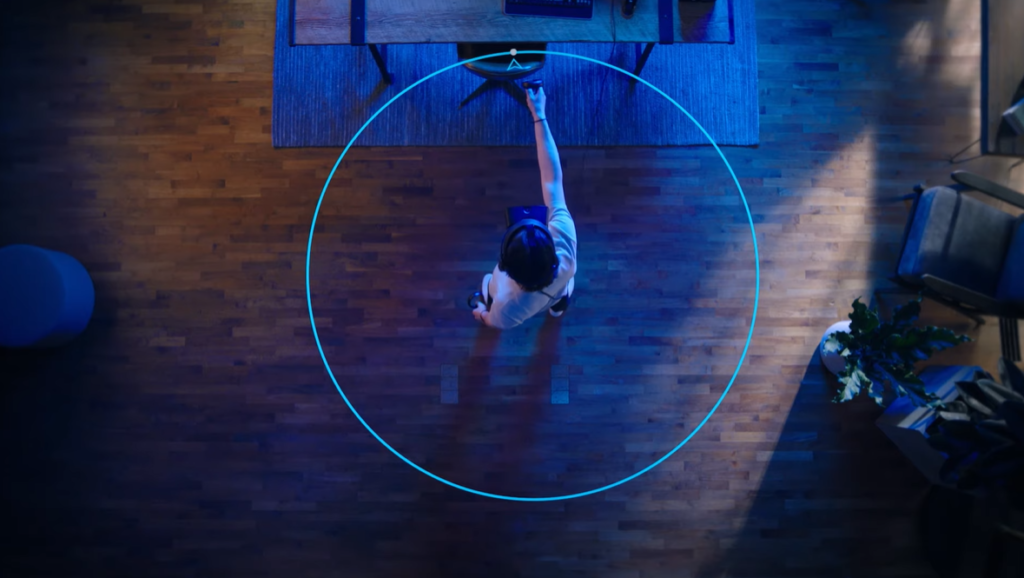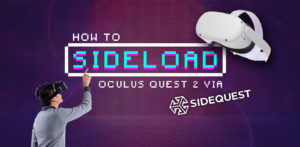With so many new headset options currently on the market, it can be difficult to know the prerequisites needed for virtual reality gaming. While headsets like the Meta Quest 2 are standalone and work right out of the box, they also work with PC too. To get the most out of your Quest 2 experience and enjoy a more powerful PCVR experience, you should try hooking it up to a PC. Other headsets like the Valve Index or Oculus Rift S are more straightforward … they need a PC full stop! So it begs the question, with all these amazing headsets to choose from, what kind of PC do I need to run PCVR? Well, let’s find out together, shall we? Here we go!
Computer Requirements For VR – Ports And Location
Ports
First things first, let’s forget about what’s under the hood for a minute and start with the basics. Your PC regardless of power needs to be in a good location. Many headsets do have a wireless streaming option which is great for free movement and immersion but is also heavily reliant on your broadband speed to maintain a stable connection. If your broadband isn’t great, you may have to remain tethered to your tower or your laptop while playing VR. The way your headset connects to your PC differs from headset to headset. The Oculus Rift S uses Display Port Connections whereas your Meta Quest 2 uses USB-C. Knowing what ports are available on the back of your laptop or PC is essential before making your VR purchase as you may not be able to connect at all if you’re careless.
Similarly, most headsets need to be connected directly to the graphics card or GPU for short. So even though your tower might have some of the correct ports or connections, you should make sure that the ports your headset needs are on your graphics card and not just somewhere else like the front of the PC. Laptops don’t have this issue but they are usually limited to only a few ports so be careful before buying.
- Photo Credit: Oculus Rift S Basics Tutorial Part 02: Play Area Setup from Meta Quest YouTube
- Photo Credit: Oculus Rift S Basics Tutorial Part 02: Play Area Setup from Meta Quest YouTube
Location
Also before delving into the wonderful world of virtual reality, you need to take note of your play space. Most of the best VR experiences require standing and or moving within a safe space. Having some clear open floor space to walk around safely is vital in this regard. If your PC is cabled under your desk in a room that is either too small or too cluttered, then consider moving your PC. Easy solution if you have a laptop as it’s portable but not such an easy task if using a PC. A play space recommendations vary between games but a minimum of 2 meters by 2 meters is needed for almost all standing VR experiences. Personally, I would recommend more but obviously, it depends on your living situation. Knowing where you’re going to be playing and working out if you need to be wired up to your laptop or PC is important before considering purchasing a VR headset today.
Minimum Requirements For VR – What Will Get You Up And Running?
Minimum PC Requirements
This is another time-sensitive question and also a little subjective. Back in 2016 when the Oculus Rift S first launched, they listed the minimum PC requirements to use the headset. These requirements were as follows:
Processor: Intel i3-6100/AMD Ryzen 3 1200, FX4350 or greater
Graphics Card: NVIDIA GTX 1050 Ti/AMD Radeon RX 470 or greater
Alternative Graphics Card: NVIDIA GTX 960 4 GB/AMD Radeon R9 290 or greater.
Operating System: Windows 10.
Memory: 8 GB RAM
The problem I have with that though is the length of time that has passed since the Oculus Rift S first launched. Over the last few years, there have been major leaps in VR technology and game development. Sure, you might be able to run older VR titles well with specs like the above, but I still feel that the minimum requirement is now a little higher. The minimum for me is to be able to run most VR titles (not all) with medium to low settings. Games need to be playable and enjoyable but not necessarily top-tier with all the bells and whistles. If your PC performance means you’re locked out of the majority of newer titles, then for me it’s no longer a minimum requirement but below.

Photo Credit: Oculus Rift S Basics Tutorial Part 02: Play Area Setup from Meta Quest YouTube
More Realistic Benchmark For Modern VR While Still Staying In The Low Range
64-bit processor and operating system
OS: Windows 10
Processor: Core i5-7500 / Ryzen 5 1600
Memory: 12 GB RAM
Graphics: GTX 1060 / RX 580 – 6GB VRAM
Specs like these will allow you to play a more modern title like Half-Life: Alyx albeit with settings down to medium or low. Still, a very enjoyable experience, and more importantly, opens up more titles for you to explore and experience without your PC overheating and exploding!
What Are The Recommended Specs For VR – Exploring The Best on The Market
And now on to the juicy meat of it all, if you’re truly serious about making any investment in virtual reality then you owe it to yourself to have a decent setup that affords you some of the best possible experiences you can have. It’s also wise to have a PC or laptop that is currently powerful but also future-proof so that you get some longevity out of your purchases. Games and VR tech are constantly evolving at a staggering rate, and it stands to reason that you should try to have some powerful processing capabilities at hand to keep up with the ever-improving platform.
Getting to play all modern VR titles with high settings and feeling comfortable while playing is a must for any serious VR enthusiasts out there. With that in mind, we’ve put together a couple of recommended specs for you to choose from. Clearly, budget should always factor into your decisions but the lists below are some of the best and highly recommended out there. Here are the recommended specs:
Recommended Specs for VR (Still Budget-Friendly)
64-bit processor and operating system
OS: Windows 10 or 11
Processor: Core-i7-12700k / Ryzen 9 3900x+
Memory: 16 GB RAM
Graphics: RTX 2080S
Hard Drive: Recommend SSD or better
Alternative (More Expensive)
Graphics Card: NVIDIA GeForce RTX 3080 equivalent or greater
CPU: Intel i7-11800 equivalent or greater
Memory: 32GB+ RAM
Video Output: Compatible HDMI 1.3 video output
USB: Ports 4x USB 3.0 ports plus 1x USB 2.0 port*
OS: Windows 11 64-bit
Frequently Asked Questions – VR Gaming on PC
What Are the Basic Requirements for VR Gaming?
To get started with virtual reality gaming, you should put your computer where it won’t be disturbed. If you want to do any sort of wireless streaming, the quality of your internet connection is more important than ever. Different headsets call for different connections, therefore it’s important to know what ports your computer has, like Display Port and USB-C.
How Important Is the Play Space for VR?
If you want to get up and move around while playing a virtual reality game, you’ll need a good-sized play area. In order to play virtual reality games in comfort and safety, a large, open area is required. If you’re playing on a PC, be sure your configuration doesn’t restrict your movement.
What Were the Minimum PC Requirements for VR in the Past?
When the Oculus Rift S was released in 2016, the following were listed as the minimum PC requirements for virtual reality:
• Processor: Intel i3-6100/AMD Ryzen 3 1200, FX4350 or greater
• Graphics Card: NVIDIA GTX 1050 Ti/AMD Radeon RX 470 or greater
• Alternative Graphics Card: NVIDIA GTX 960 4 GB/AMD Radeon R9 290 or greater
• Operating System: Windows 10
• Memory: 8 GB RAM
But keep in mind that the VR landscape has changed, and some newer titles may require more powerful hardware to run smoothly.
What Are More Realistic Minimum Requirements for Modern VR?
The following system requirements will help you get the most out of your virtual reality games.
• 64-bit processor and operating system
• OS: Windows 10
• Processor: Core i5-7500 / Ryzen 5 1600
• Memory: 12 GB RAM
• Graphics: GTX 1060 / RX 580 – 6GB VRAM
With those specs, you should be able to play modern VR games on medium or low settings.
What Are the Recommended Specs for a High-Quality VR Experience?
If you want to get the most out of virtual reality (VR) gaming and experience the greatest content out there, you should need a high-end computer. Specifications are as follows…
Recommended Specs for VR (Still Budget-Friendly):
• 64-bit processor and operating system
• OS: Windows 10 or 11
• Processor: Core-i7-12700k / Ryzen 9 3900x+
• Memory: 16 GB RAM
• Graphics: RTX 2080S
• Hard Drive: Recommended SSD or better
Alternative (More Expensive):
• Graphics Card: NVIDIA GeForce RTX 3080 equivalent or greater
• CPU: Intel i7-11800 equivalent or greater
• Memory: 32GB+ RAM
• Video Output: Compatible HDMI 1.3 Video Streaming
• USB: Ports 4x USB 3.0 ports plus 1x USB 2.0 port*
• OS: Windows 11 64-bit
With these requirements, you’ll be able to experience virtual reality at a professional level.
How Can I Ensure Compatibility Between My PC and VR Headset?
Make sure your computer has the appropriate ports and connections, like Display Port or USB-C, for the VR headset you intend to buy before making a purchase. Also, before purchasing games on services like Steam, make sure your graphics card and computer meet the system requirements.
What Are Some Pro Tips for Choosing a VR Setup?
Inspect the laptop or computer’s ports regularly.
Think about your PC’s portability and whether or not you’d benefit from a larger playing area.
Make sure there’s enough room for players to stand or move about while playing.
Take a look at your graphics card’s specs and the VR games’ system requirements.
Maintain a spending plan that is reasonable given your financial situation.
If you want to avoid tethering yourself to a power source, wireless streaming may be the way to go.
Can I Use a Laptop for VR Gaming?
A laptop can be used for virtual reality gaming, but it needs to match the requirements of the VR headset you plan to use. Virtual reality (VR) gaming on a laptop has many advantages, including portability and convenience, but only if the device has the necessary connectors and hardware capabilities.
What About Wireless Streaming for VR?
Some virtual reality headsets support wireless streaming, allowing you to walk around without being tied down to a computer. However, the reliability of your connection is highly dependent on the bandwidth available to you. You may be stuck in front of your computer if your internet connection drops frequently.
Are There Any VR Headsets That Don’t Require a PC?
The Meta Quest 2 is one example of a PC-independent virtual reality headset. Thanks to their built-in processing power and storage, they are an excellent option for cordless VR gaming. For a more robust virtual reality experience, however, they can be linked to a personal computer.
Can I Upgrade My PC for Better VR Performance?
You can improve your PC’s virtual reality performance, thus yes. Improving your virtual reality gaming experience can be as simple as upgrading your graphics card, CPU, or RAM. Before purchasing a virtual reality headset, be sure it meets the system requirements.
What Should I Consider When Setting Up My Play Space?
Think about where your PC will be and how much free space you’ll need when designing your virtual reality play area. Make sure there are no things people could trip over. Most virtual reality experiences designed to be played while standing require a minimum play area of 2 metres by 2 metres.
What Should I Do if My PC Doesn’t Meet the Recommended Specs?
Adjusting the graphical settings in-game may allow you to play virtual reality games even if your PC doesn’t fulfil the minimum requirements. This can make VR games usable on less capable platforms at the cost of some visual richness.
Are There VR Games Specifically Designed for Lower-End PCs?
Yes, there are virtual reality games optimised for low-end computers. These games cater to a wider audience because they typically have lower graphics and hardware requirements. Try to find titles that state they are compatible with less powerful PCs.
Can I Try VR Before Committing to a Purchase?
Virtual reality arcades, gaming conferences, and electrical stores all provide a wide variety of VR games and experiences for customers to try. You can give virtual reality a try before committing to a purchase. If you buy a virtual reality headset and find that you don’t like it, the company may let you return it.
Are There Any Free VR Experiences to Get Started?
You can get your feet wet in virtual reality (VR) without spending any money, as there are plenty of free experiences and games accessible. You can get your feet wet in virtual reality (VR) without spending any money right now thanks to free titles available on platforms like SteamVR and the Oculus Store.You should be able to make more educated selections now that you know what’s required to play virtual reality games on a personal computer. There are many fascinating things to do in the world of virtual reality gaming, whether you’re updating your current setup or just getting started. Always double-check the VR headset’s compatibility with your PC and the system requirements before making a purchase. You can experience amazing experiences in virtual worlds as soon as you have the right equipment. Let the virtual reality games begin!
Overall
There you have it, folks. Lots of solid information and advice to consider before making your purchases. Another pro tip is always to measure your enthusiasm against your budget restraints, don’t go buying anything you can’t afford. VR is a wonderful medium and can offer limitless entertainment, but it also doesn’t have to cost a fortune. We’ll leave you with some small tips below to bear in mind when choosing your next virtual reality headset.
If you’d rather learn about what gaming laptops are great for virtual reality, then check this article out.
PC Requirements for VR Pro Tips
Check connection ports on your PC/Laptop
Check the portability of the PC and consider moving to a bigger space
Make sure you have a sufficient play area wherever you decide to set up
Check your GPU and review games’ minimum requirements on Steam
Check out the game requirements for the ones you’d most like to play
Stick to a budget
Check if wireless streaming is a viable option







